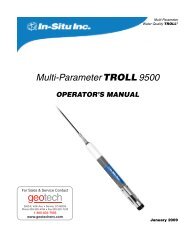TEST INSTRUCTIONS - Geotech Environmental Equipment
TEST INSTRUCTIONS - Geotech Environmental Equipment
TEST INSTRUCTIONS - Geotech Environmental Equipment
Create successful ePaper yourself
Turn your PDF publications into a flip-book with our unique Google optimized e-Paper software.
CHROMIUM–HEXAVALENT,<br />
TRIVALENT & TOTAL<br />
DIPHENYLCARBOHYDRAZIDE METHOD CODE 3698-SC<br />
QUANTITY CONTENTS CODE<br />
60 mL *Sulfuric Acid, 5N *7681-H<br />
10 g *Chromium Reagent Powder *V-6276-D<br />
15 mL *Sodium Azide, 5% *7683-E<br />
30 mL Potassium Permanganate, 0.5% 7682-G<br />
60 mL Deionized Water 5115PT-H<br />
1 Pipet, plain, glass, w/cap 0341<br />
1 Pipet, 1.0 mL, plastic 0354<br />
1 Spoon, 0.1 g, plastic 0699<br />
1 Graduated Cylinder, 50 mL, glass 0418<br />
1 Erlenmeyer Flask, 125 mL, glass 0431<br />
1 Test tube holder 1113<br />
1 Filter Paper 0465<br />
1 Funnel, Plastic 0459<br />
*WARNING: Reagents marked with an * are considered hazardous substances. To<br />
view or print a Material Safety Data Sheet (MSDS) for these reagents see MSDS CD<br />
or our web site. To obtain a printed copy, contact us by e-mail, phone or fax.<br />
A toxic chemical, chromium is found in two forms in the water; trivalent<br />
chromium (Cr3+) and hexavalent chromium (Cr 6+). Chromium enters the<br />
water from industrial waste. Hexavalent chromium is more toxic than trivalent<br />
chromium. Levels greater than 0.5 ppm indicate improperly treated industrial<br />
waste. It is important to maintain chromium levels at or below 0.5 ppm,<br />
because clams and other shellfish will store chromium in their systems,<br />
accumulating levels which may be dangerous to the consumer, whether human<br />
or animal.<br />
APPLICATION: Drinking, surface, & saline water; domestic and industrial<br />
waste.<br />
RANGE: 0.00–1.00 Chromium<br />
METHOD: The trivalent chromium is converted to hexavalent<br />
chromium by permanganate under acidic conditions.<br />
Hexavalent chromium reacts with 1,5<br />
diphenylcarbohydrazide under acidic conditions to form a<br />
red-purple color in proportion to the amount of chromium<br />
present.<br />
Smart2 <strong>TEST</strong> PROCEDURES 10.04 Chromium–Hexavalent, Trivalent & Total 1/4

















